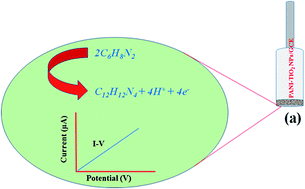Retracted Article: The fabrication of a chemical sensor with PANI-TiO2 nanocomposites
Abstract
In this study, conjugated conducting polyaniline was fabricated onto titania nanoparticles (PANI-TiO2 NPs) using a microwave-accelerated reaction system. The synthesized nanoparticles were characterized using the techniques of electron microscopy (e.g., FE-SEM and TEM), X-ray diffraction (XRD), Fourier-transform infrared spectroscopy (FT-IR), and ultraviolet-visible (UV-Vis) spectrometry. An ultrasensitive sensor using the electrochemical (I–V) approach was fabricated using a thin film of PANI-TiO2 NPs on a glassy carbon electrode (GCE), and it was found to be selective towards 1,2-diaminobenzene (1,2-DAB) in a buffer phase. From current versus concentration studies, the calibration curve was plotted to estimate the sensor's analytical parameters. The highest sensitivity (19.8165 μA μM−1 cm−2) and lowest detection limit (0.93 ± 0.05 pM) were obtained from the electrochemical assessment by applying a signal-to-noise ratio of 3. A linear calibration plot was attained over a large range of concentration (LDR: 1.0 pM to 0.01 mM). The selective 1,2-DAB sensor was found to be efficient and reproducible in performance, yielding significant results with a fast response time (12.0 s). Therefore, the overall results of the 1,2-DAB chemical sensor suggest that this detection approach might be an easy way to develop an efficient electrochemical sensor for the protection of the environment as well as for use in the healthcare field on a broad scale.



 Please wait while we load your content...
Please wait while we load your content...